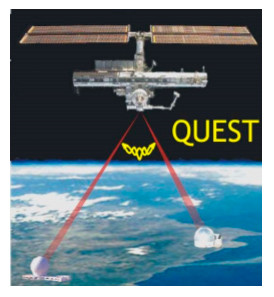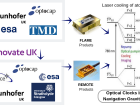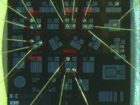Quantum Transceiver for secure Space Communications

1. Distribution of pairs of entangled photons using the International Space Station (ISS). Entangled photon pairs are distributed to two separated places on Earth.
ABSTRACT: We report on the development of a photonic transceiver for secure space communication, including an entangled photon source and a faint pulse laser source. Through the laws of Quantum Physics, it will allow the development of global communication with unprecedented security. The report was carried out by professionals of the sector where Alter Technology Spain has worked with conjointly with companies such ICFO, ICREA or LIDAX among other.
Introduction
Quantum communications offers many advantages for secure data transmission, e.g. confidentiality, integrity, eavesdropper’s detectability. Information is encoded in quantum bits (qubits), intrinsic physical properties, such as polarization of a photon. Quantum physics allows encoding information using the correlation between two or more particles (photons, atoms). Quantum Key Distribution (QKD) is one of the innovative methods of information processing that emerged from the properties of “superposition of states” and “entanglement”.
QKD allows two (or more) parties to know when a communication channel is completely secure to exchange an encrypted key. QKD is used before classical information is transmitted over conventional non-secure communication channels like telephone lines, RF links and optical fibre networks. Since quantum physics laws state that a single particle like a photon cannot be split or cloned, it certifies the absolute security of communication.
Quantum communication channels however are limited on Earth. Optical fibre link losses and current photon-detector technology limit the maximum span length without using regeneration (amplification) to 100 km, while for free space transmission the limit is the visible horizon [1, 2]. Such problems are in principle nearly absent in space, and are less severe in ground to space links. In fact, quantum links in Free space combined with fibre counterparts could extend secure communication between points on earth to a global level (Fig. 1). In addition space applications requiring secure link are numerous: remote access, communication between distant ground stations via space segment, positioning systems (GALILEO), etc….
Various proof-of-principle experiments have been already performed. For example, a 144 km free-space link between the two Canary Islands La Palma and Tenerife used the ESA’s 1-meter-diameter receiver telescope to receive single photons [3, 4]. A satellite-to- Earth link was also simulated between the Matera-Laser-Ranging-Observatory (Italy) and the low-earth orbit (LEO) satellite Ajisai.
In this paper, we present a mandatory subsystem for quantum communication in space, a photonic transceiver capable of generating and detecting entangled photons as well as faint laser pulses, which we call Quantum Transceiver (QTxRx). The QTxRx has to fulfil highly demanding specifications for space applications, i.e. a total size < 200 x 150 x 100 mm3, a mass < 3 kg and a peak total power consumption (including electronics) < 15 W as well as all the severe environmental requirements (vibration, shock temperature, radiation).
- LED Technologies & Properties - 2nd February 2016
- Fast optical source for quantum key distribution based on semiconductor optical amplifiers - 1st February 2016
- Low Temperature Radiation Test of High Voltage Optocouplers for Space Applications - 1st February 2016



